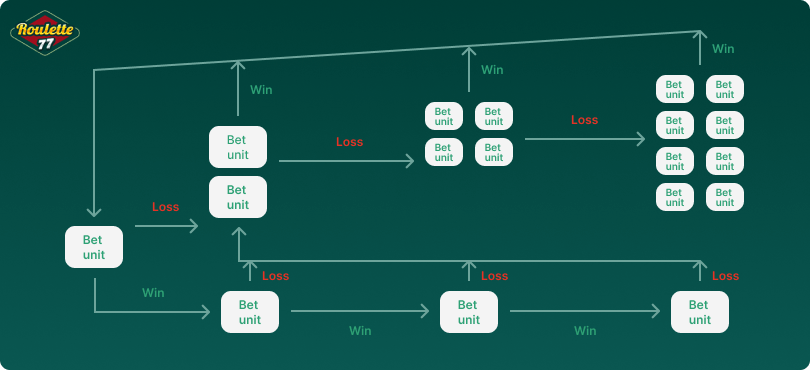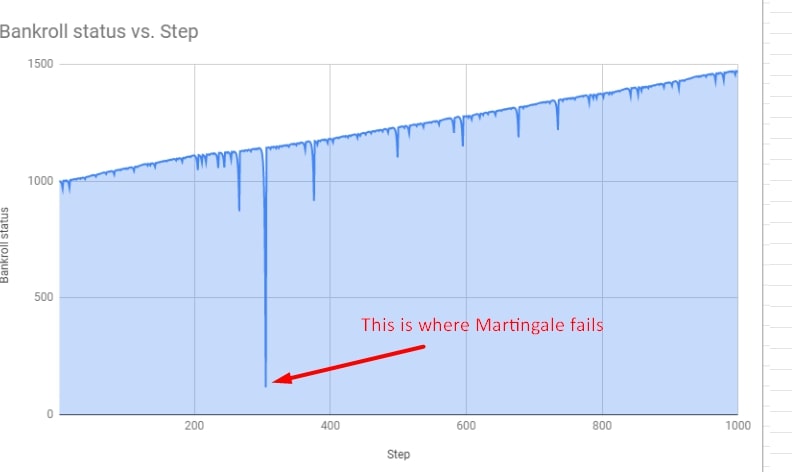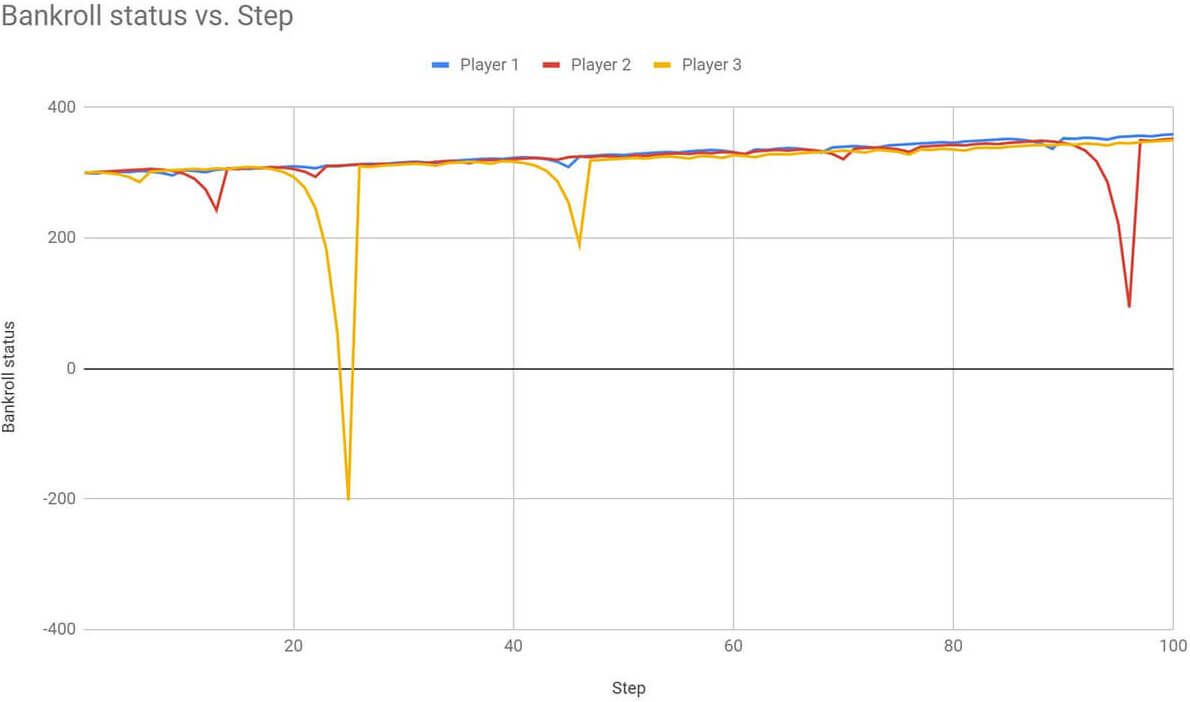Testing and Analyzing Martingale System for Roulette
The Martingale system is one of the most popular betting strategies on the planet. In addition to being used in a wide range of betting situations including sports wagering and blackjack, it’s also one of the top choices for roulette players. In this guide, we will discuss this beloved yet controversial gambling stratagem. We will talk about how it has become accessible to the broader community of roulette players and what makes it the go-to game plan for so many roulette players.
A lot of newbies misunderstand the Martingale system. Many of them think that this method is a guaranteed money maker. The first thing you need to understand is that the Martingale strategy offers no such guarantees. The same can be said of any betting system. As such, we will speak of the mathematical justification for using the strategy and what its strengths and weaknesses are.
Let’s start with a little background. The Martingale System was developed by French mathematician Paul Pierre Levy in the 18th century. He posited that one good bet or trade will be enough to turn one’s fortune around. The strategy is widely used and applied across other games and betting situations too. So, let’s dive into the mathematical aspects of the strategy and illustrate its strengths and weaknesses. Let’s start!
How Does the Martingale Strategy Work?
Martingale is a simple enough strategy which is one of the reasons why so many people use it. The plan of attack requires players to gradually increase their bet amount after a losing round. While we will use a $1 base unit to keep it simple, this is just an arbitrary baseline. If a particular table allows it, you can start with smaller bets like $0.10. Those with bigger bankrolls could make the base amount $100 or more.
The Martingale system essentially instructs you to wager the base stake amount every time you win. If you lose, you keep doubling your stake until you win. With the increased stake amount, you compensate for your previous losses. Then you go back to the base unit. As you can see, this is a simple enough strategy. However, you need to remember that the Martingale strategy only works for even money bets like Red/Black, Even/Odd, and High/Low bets. Below, you can find a diagram that helps explain the strategy:

Let’s make sure you understand the fundamental concept of the Martingale roulette strategy by looking at an example of the system in action. We will use a $1 base unit and play through five rounds. Here we go!!
- Spin 1
We wager $1 on red and lose. This means we double our stake to $2 for the next spin.
- Spin 2
In accordance with the Martingale system, we wager $2 on red for the second spin. Unfortunately, this one also loses. We must now raise the bet to $4 for the next spin.
- Spin 3
We wager $4 on red, but we lose this one too. When will the roulette gods cut us some slack? We must now increase our stake to $8.
- Spin 4
We bet $8 on red. This time we notched a victory. Now that we have won, our stake must revert back to the $1 base amount.
- Spin 5
We wager $1 on red and it’s a winner. If we decide to continue playing, our next wager will be $1.
Testing the Martingale System
To help you figure out the Martingale system and its effectiveness, our team has taken it upon itself to find out if the method is actually efficient and, if so, to what extent this efficiency goes. To achieve this, we created a special test using Google Sheets based on an RNG with specific probabilities. Why do we use Google Sheets? Because it’s a lot easier and less time-consuming than testing the strategy in a live game. Also, testing in a live game would be more difficult to illustrate in a diagram. So, we simulated 1,000 spins following the Martingale algorithm. We used a base betting unit of $1 and a $1,000 bankroll. Our diagram shows how efficient the system was and how it impacted our bankroll. In the end, we were ultimately able to increase our bankroll. However, there were one or two scary moments along the way.

At first glance, you might be inclined to celebrate because the graph shows increasing growth in the bankroll. However, not everything is what it seems to be. Take note of how the bankroll plummets to just $118 after the 300th move? Here, in natural conditions, the algorithm itself comes to a standstill. In this case, with a bankroll of $1140, a series of 10 consecutive losses occurred. As a result, the total amount lost was 1+2+4+8+16+32+64+128+256+512=$1023. According to the system, the next step calls for a wager of $1024. However, with only $118 remaining in the bankroll, we can’t do that. So here, in natural conditions, the progression comes to a grinding halt.
We must now decide whether to reset and go back to the original base unit, resort to a different strategy, or end the game. Even though we see consistent growth on our graph, this particular model assumes we have an unlimited bankroll and no betting limits.
Now let's conduct a similar experiment. This time, we’ll incorporate more realistic conditions. We’ll set the bankroll at $300, keep the $1 base unit, and decrease the number of moves to 100. For objectivity, let's run the experiment using three players.

As the diagram shows, the first player made it through to the 100th spin, winning $359 for a gain of $59. The second one hit the cap at around the 96th spin and was left with $94. The third player hit the progression on the 25th spin resulting in a net bankroll of $54. So, what does this example tell us? It’s simple: Martingale fails if a series of losses stacks high enough to interrupt your progression.
In our example, we saw ten losses in a row. The probability of this happening in European roulette is 0.1275% while the odds of this occurring in American roulette are 0.1631%.
While the probabilities appear to be quite remote at first, it really isn’t such a long shot when you extrapolate the odds over 1,000 spins. Suddenly, it’s not such an unlikely outcome. In the second example we gave, the second and third players were forced out of the progression after 8 consecutive losses. The probability of that happening was 0.5683% in European roulette and 0.5859 in American roulette.
Pitfalls of the Martingale System
We have definitely learned some things about the Martingale strategy so far. Let’s go over the main weaknesses. To do this, we will break these dangers down into three individual sub-sections for the sake of convenience.
Betting Limits
The first thing you need to be aware of when using this strategy is that a few consecutive losses may force you to go beyond the table limits. Of course, you can’t do that. If this happens, you’re going to have to pack it in or go with a different strategy.
The maximum limits for even-money roulette bets can reach several thousand and even tens of thousands of dollars. In that case, it’s unlikely that you’ll reach the limits assuming you’re using a reasonable base stake. But table limits can also be a lot lower which restricts your ability to keep doubling your stake. You need to make sure that your bankroll can endure long cold streaks.
Bankroll
The Martingale system is a progressive strategy that requires continuously doubling your stake amount during a losing streak. For this reason, players with bigger bankrolls are more likely to endure the Martingale progression longer. Of course, this is assuming that their base wagers are in line with their bankrolls.
Time and Patience
The key to winning with the Martingale system is to play consistently. You need to play at least 100 spins of the game to maximize your chances of making it work. This is why you should never worry about immediately turning a profit. Instead, stick to the algorithm and pray that it doesn’t break too early.
Conclusion
When looking for roulette betting strategies on the Internet, you will inevitably encounter the Martingale method. Many sources will present it as a “winning” strategy. Such rhetoric only discredits the authors of such articles. In a lot of cases, they simply want to mislead readers and convince them to use this strategy at an online casino through their affiliate link. So, in conclusion, we will highlight a few basic points that we found out about the strategy.
First off, the Martingale strategy works perfectly only in theory where there are no limits on bets and you have unlimited money.
Second, you need to play for a long time to win even a small amount of money. Since Martingale provides even money bets with low volatility, the progression moves rather slowly.
The third revelation is that you will eventually be forced to go beyond your bankroll and table betting limits. In short, there comes a time when it is impossible to follow the progress and you need to employ a different strategy or bow out of the game.
Finally, we would not describe the Martingale system as a “scam strategy” as some sources characterize it. It’s just that you should never view it as a surefire lock because it simply isn’t. While it can backfire spectacularly, you can most likely win a small amount of money with it. Just remember to walk away at the right time.
Your new strategy is waiting to be tested - play roulette for real!
-
1
 21Bets
21BetsAccepts UK players
Bonus 120% up to €600Wagering requirement x45Roulette games 50+Live dealerPayments -
-
2
 Trada Casino
Trada CasinoAccepts UK players
Bonus 100% up to £150Wagering requirement x35Roulette games 30+Live dealerPayments -
-
3
 888 Casino
888 CasinoAccepts UK players
Bonus 100% up to £100Wagering requirement x30Roulette games 60+Live dealerPayments -
-
4
 NineWin
NineWinAccepts UK players
Bonus 100% up to £450Wagering requirement x35Roulette games 15+Live dealerPayments -
-
5
 NonStop Casino
NonStop CasinoAccepts UK players
Bonus 400% up to £3000Wagering requirement x45Roulette games 30+Live dealerPayments -
-
6
 Greenplay
GreenplayAccepts UK players
Bonus 100% up to £25Wagering requirement x35Roulette games 20+Live dealerPayments -
-
7
 BloodMoon
BloodMoonAccepts UK players
Bonus 400% up to £800Wagering requirement x45Roulette games 50+Live dealerPayments -
-
8
 Lucky Thrillz Casino
Lucky Thrillz CasinoAccepts UK players
Bonus 100% up to £25Wagering requirement x35Roulette games 40+Live dealerPayments -
-
9
 Mr.Play Casino
Mr.Play CasinoAccepts UK players
Bonus 100% up to £200Wagering requirement x35Roulette games 50+Live dealerPayments -
-
10
 Scatter Hall
Scatter HallAccepts UK players
Bonus 100% up to €1 000Wagering requirement x40Roulette games 10+Live dealerPayments -

























